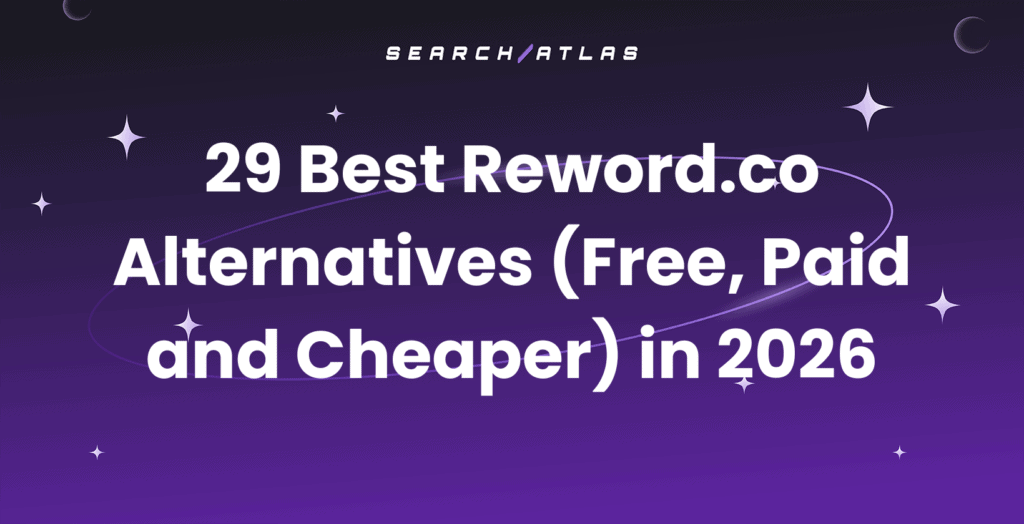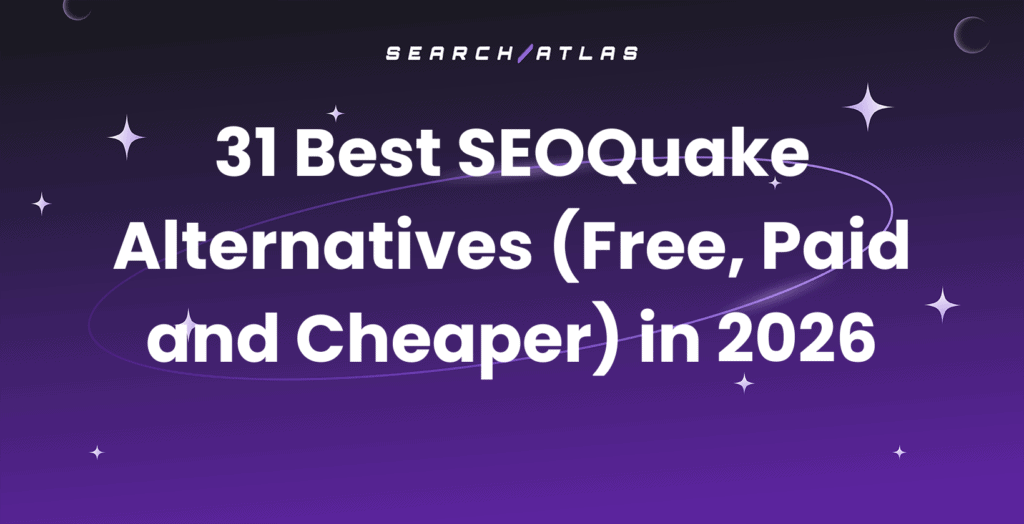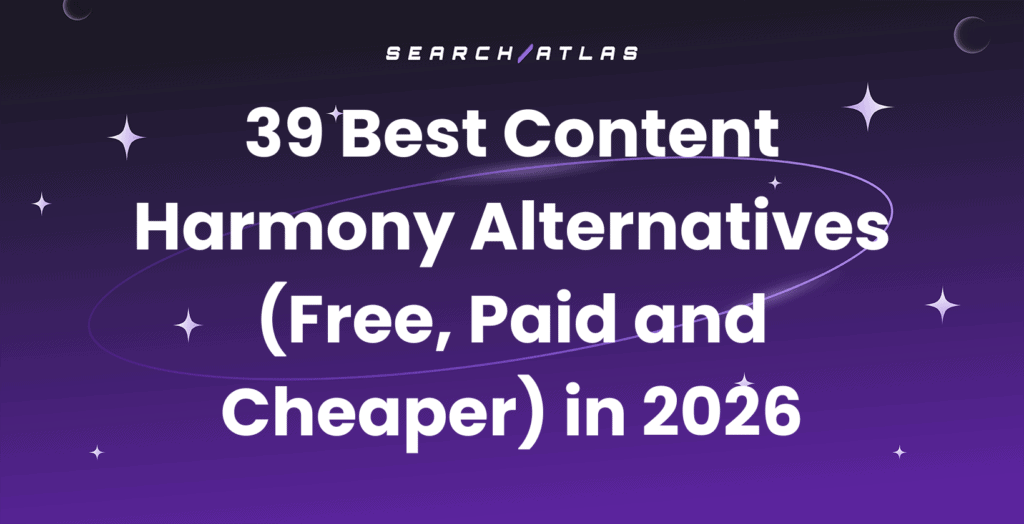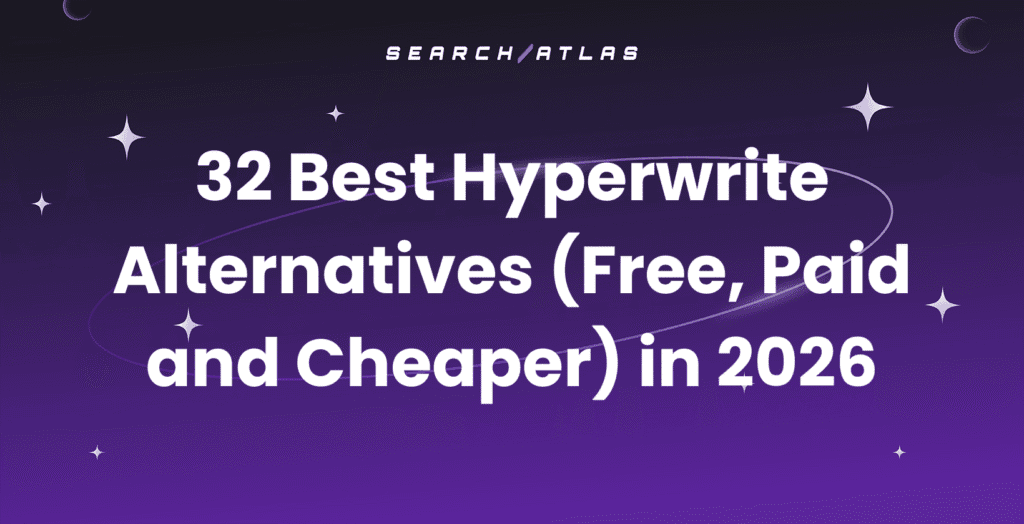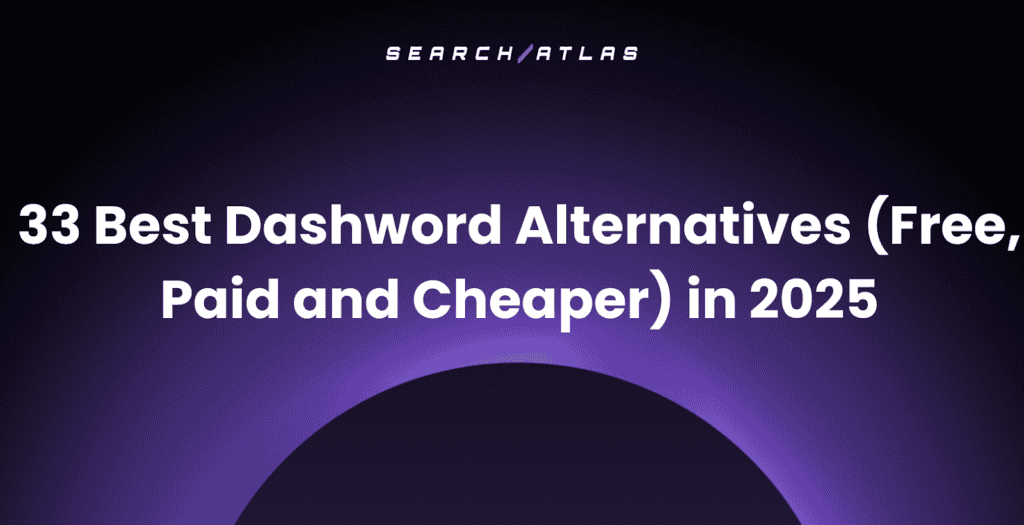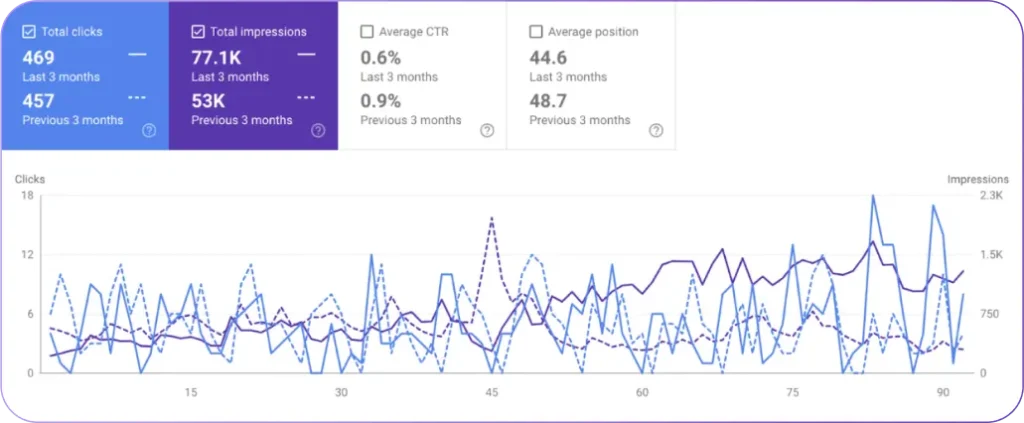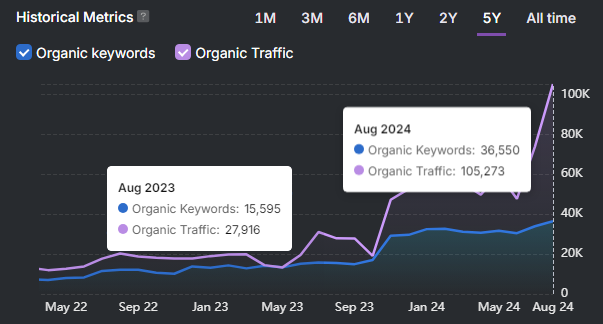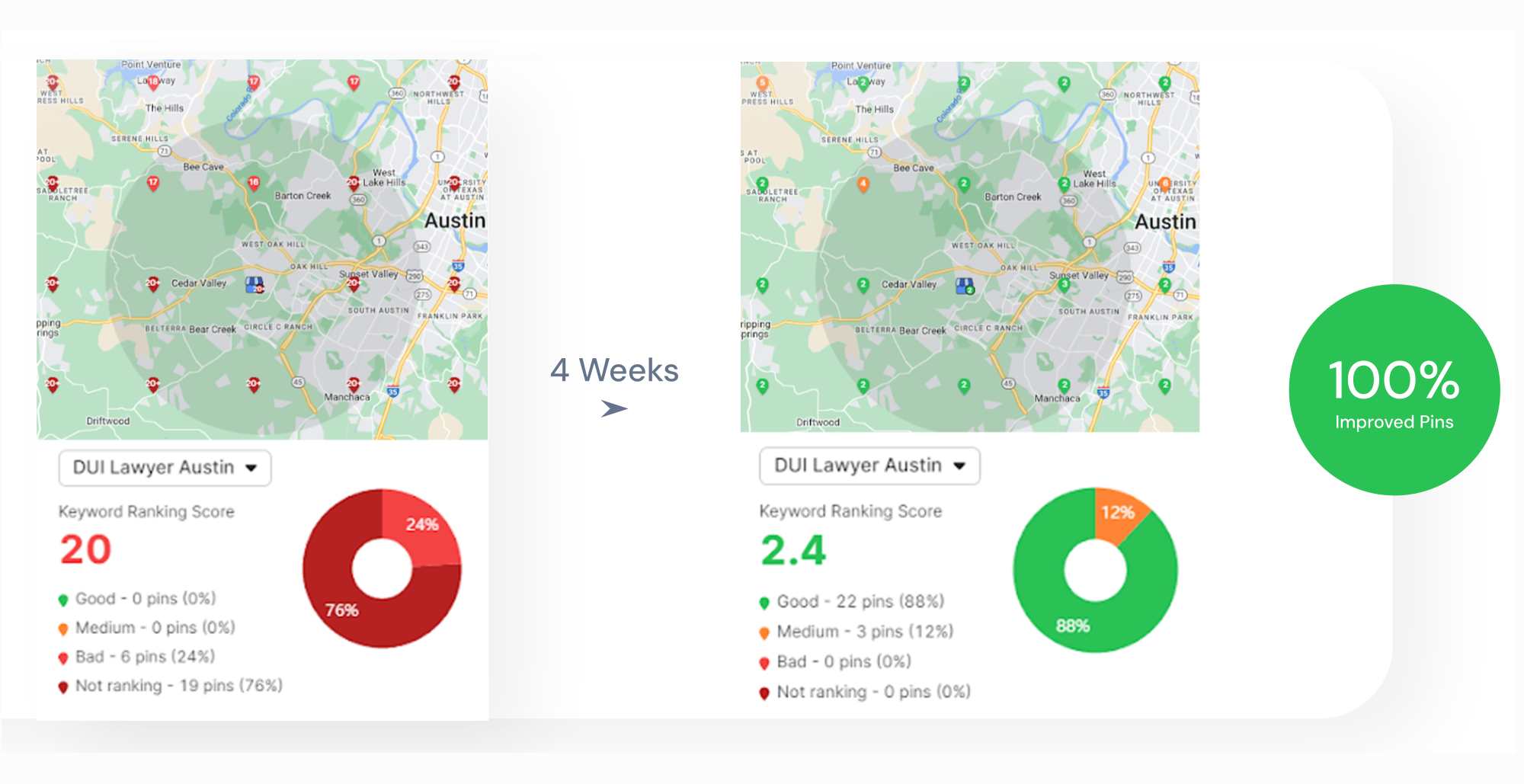B2C SEO (business-to-consumer SEO) refers to search engine optimization strategies designed to attract and convert individual consumers. B2C SEO focuses on short buying cycles, emotional triggers, and impulse-driven search behavior. Business to consumer SEO relies on high-volume keywords, seasonal trends, and conversion-optimized content to capture search demand from users looking for entertainment, fashion, food, wellness, or retail products.
B2C search engine optimization is important because it delivers organic traffic without relying on paid ads. It scales reach while keeping acquisition costs low. As search behavior becomes more visual, mobile-first, and voice-assisted, B2C SEO techniques now include structured data, image SEO, and real-time search alignment.
Brands that invest in long-tail content, product-driven landing pages, and user-generated reviews win visibility across informational and transactional queries. This B2C SEO guide covers how to rank in 2025 using the best techniques, how to audit performance, and which SEO tools help B2C marketers grow faster.
What is B2C SEO?
B2C SEO is the practice of optimizing websites, product pages, and content to improve visibility in search engines for individual consumers. Short for “business-to-consumer search engine optimization,” B2C SEO targets high-volume, emotionally driven queries that influence everyday purchase decisions. B2C searches often include transactional keywords like “best running shoes under $100,” location-based phrases like “pizza near me,” or product-specific terms like “anti-aging serum with retinol.”
Unlike B2B search engine optimization, which addresses long sales cycles and committee-based decisions, SEO for B2C focuses on speed, simplicity, and immediate conversions. Successful B2C strategies use keyword-rich category pages, optimized product listings, customer reviews, and lifestyle blog content to capture intent across the entire buyer journey. Ranking well for B2C queries increases organic traffic, brand exposure, and revenue, especially when optimized for mobile, local, and visual search results.
What is the Importance of SEO for B2C?
SEO for B2C companies plays a critical role in generating organic visibility, driving consistent traffic, and converting users without relying on paid advertising. B2C SEO creates a long-term foundation for growth by placing content, product pages, and brand assets in front of consumers during high-intent searches. Search engine traffic compounds over time, which means each optimized page becomes a scalable acquisition asset.
For B2C companies, organic search is often the highest-converting channel because it intercepts demand from users already researching products, reading reviews, or comparing prices. By ranking for non-branded queries like “best gifts for new moms” or “affordable vegan snacks,” brands capture new customers before the ad of their competitor ever loads.
B2C SEO supports content marketing, retargeting, email list building, and brand recall by turning every ranked page into a traffic source.
How to rank for B2C using the best SEO Techniques?
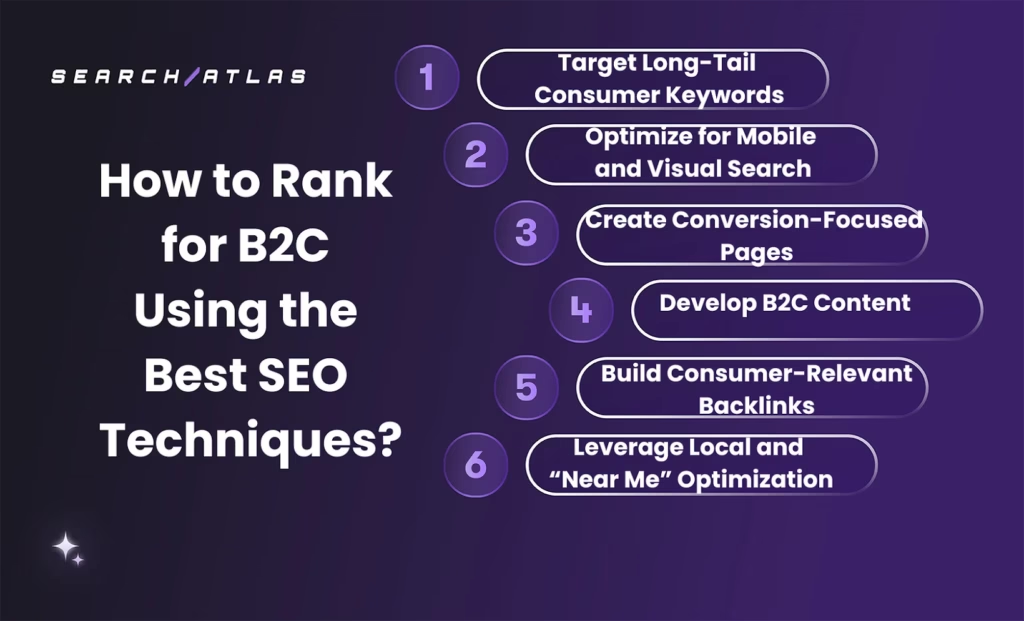
The best B2C SEO techniques focus on targeting high-intent consumer searches, optimizing for mobile-first indexing, and creating conversion-driven content experiences. The best practices for B2C SEO combine keyword targeting, technical optimization, and audience-focused storytelling to capture attention in competitive search results.
The top techniques to make content rank for B2C in 2025 are listed below.
1. Target Long-Tail Consumer Keywords
A B2C keyword strategy begins with identifying and optimizing for long-tail keywords that capture specific product needs, seasonal trends, or consumer preferences.
Long-tail keywords typically contain three or more words, allowing brands to target niche demand while avoiding the high competition of short, generic terms. In the B2C market, long-tail queries often signal strong purchase intent, such as “best noise-cancelling headphones under $200” or “organic baby formula with free shipping.”
Long-tail keyword targeting improves search visibility by aligning closely with what buyers type during the final stages of the decision process. For B2C companies, ranking for these terms means intercepting consumers just before they click “add to cart.”
The best practices for B2C long-tail keyword targeting are below.
- Group related long-tail terms into thematic clusters for category and subcategory pages.
- Prioritize queries that include product attributes, location modifiers, or urgency signals.
- Map each keyword cluster to a dedicated page optimized for both search and conversion.
For example, a home décor retailer might target “modern farmhouse coffee table with storage” for a product page while building supporting blog content on “5 farmhouse décor trends for 2025” to strengthen topical authority.
To find profitable long-tail keywords, the Search Atlas Keyword Research Tool offers far more than just search volume and difficulty scores. The Search Atlas Keyword Research Tool has a 5.2B keyword index, which includes consumer-specific intent labels, seasonal trend markers, and competitor overlap detection. It allows B2C brands to build campaigns that anticipate demand surges before competitors.
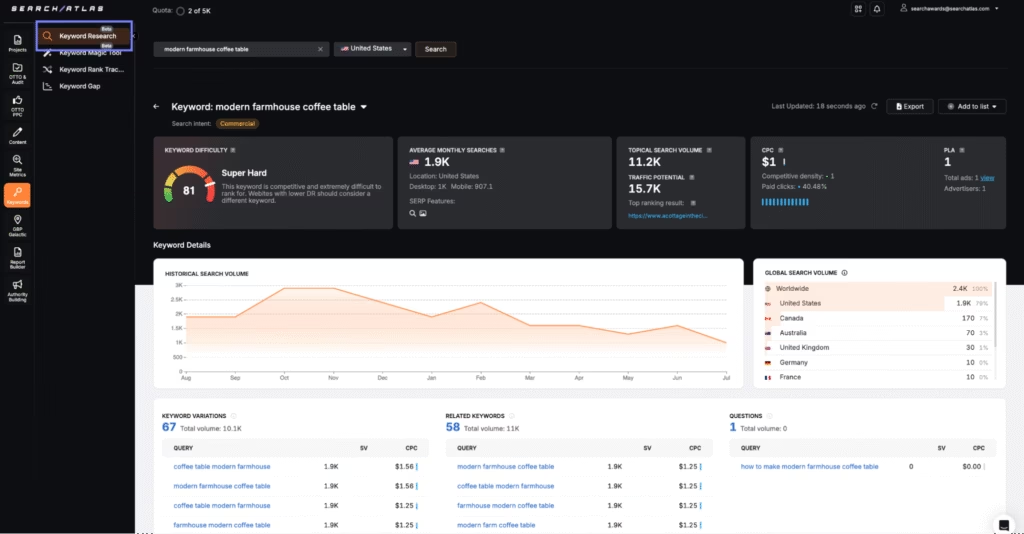
By pairing it with the Search Atlas Keyword Gap Tool, marketers surface terms that rival sites rank for but they don’t, then immediately feed those into the Search Atlas Content Genius for semantically optimized page creation. This integration cuts research-to-publish time from weeks to days while keeping every asset aligned with actual buying intent.
2. Optimize for Mobile-First and Visual Search
Mobile-first and visual search optimization is the B2C baseline for ranking and conversions. More than 60% of consumer searches now originate on mobile devices, with a significant share using Google Lens, visual search, or image-heavy SERP features. For B2C companies, this means that product images, page layouts, and load speeds directly influence both search rankings and buying decisions.
A mobile-first approach ensures that every page loads quickly, adapts to various screen sizes, and maintains full functionality without requiring zooming or horizontal scrolling. Visual search optimization takes this further by treating images as discoverable assets, optimizing alt text, file names, captions, and schema so that products surface in Google Images, Shopping, and Lens results.
The best practices for mobile-first and visual search optimization are below.
- Use responsive design with a mobile-first CSS framework to prioritize small-screen layouts.
- Compress images without losing clarity, using next-gen formats like WebP or AVIF.
- Apply product schema and image object markup to improve SERP eligibility.
- Optimize touch elements, ensuring buttons and menus are easy to interact with on smaller devices.
For example, a fashion retailer targeting “summer maxi dress” would include high-resolution lifestyle images tagged with descriptive alt text like “bohemian summer maxi dress with floral print,” paired with structured product markup for pricing, color, and availability.
The Search Atlas Site Auditor identifies mobile rendering issues, slow-loading assets, and schema errors at scale, flagging exactly which elements prevent compliance with Google’s mobile-first indexing. Search Atlas Site Auditor drills into individual product pages to verify Core Web Vitals, image optimization scores, and structured data accuracy.
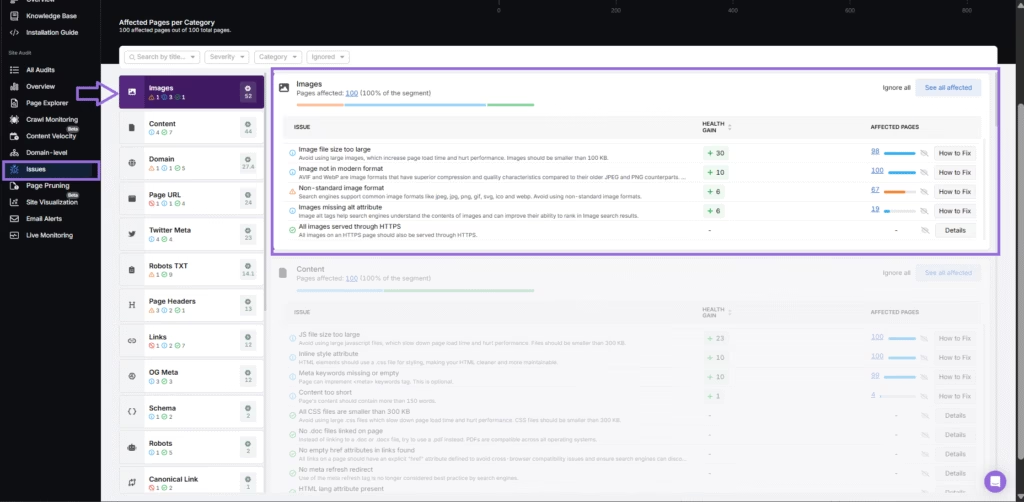
For brands investing in visual commerce, integrating the Search Atlas Schema Markup Generator ensures every image and product field is machine-readable, boosting eligibility for Google Images, Shopping ads, and rich product snippets. This combined workflow turns mobile and visual optimization into a measurable ranking advantage rather than a compliance checkbox.
3. Create Conversion-Focused Product and Category Pages
Product and category pages in B2C SEO are high-value entry points for organic traffic. When properly optimized, these pages can rank for both head terms (“wireless earbuds”) and long-tail purchase queries (“noise-cancelling wireless earbuds under $150”). They capture users at multiple stages of the buying journey.
A conversion-focused approach combines keyword targeting with persuasive copy, structured data, and trust signals to move visitors from search result to checkout in as few clicks as possible.
Optimized product and category pages balance user experience with search intent. This means ensuring keyword placement in titles, descriptions, and H1 tags without compromising readability, and supporting them with original images, feature breakdowns, and user reviews. Category pages should function as topical hubs, internally linking to related subcategories, top products, and relevant content pieces to distribute authority across the site.
The steps for conversion-focused page optimization are below.
- Map primary keywords to individual product and category pages to avoid cannibalization.
- Use unique, benefit-driven descriptions rather than manufacturer-provided copy.
- Incorporate rich media like videos, 360° product views, or size/fit guides to reduce returns and increase buyer confidence.
- Include structured product data for price, availability, and ratings to qualify for rich results.
For example, an electronics store could optimize its “gaming laptops” category for high-volume search terms, while individual product pages target brand-specific and spec-based queries like “ASUS gaming laptop with RTX 4070.” Internal links from the category page to buyer’s guides and comparison articles further strengthen topical relevance.
The Search Atlas Content Genius tool streamlines this process by generating semantically rich copy for both product and category pages using live SERP analysis. Search Atlas Content Genius ensures that headings, keywords, and entity coverage match the strongest-ranking competitors.
4. Develop B2C Content That Inspires and Converts
A B2C content strategy focuses on creating resources that attract search traffic and encourage purchases through inspiration, trends, and lifestyle relevance.
Effective B2C formats include buying guides, seasonal roundups, product comparisons, and how-to articles that align with consumer search intent. B2C SEO content should balance entertainment with conversion by linking directly to relevant product or category pages.
The best practices for B2C content creation are below.
- Address different buying stages, from inspiration (“Top 10 Summer Outfit Ideas”) to decision-making (“Best Waterproof Sandals for Beach Trips”).
- Incorporate trending keywords and seasonal search data to ride consumer interest peaks.
- Use authentic visuals, influencer collaborations, and customer testimonials to increase trust and engagement.
- Interlink content with product and category pages to guide the buyer journey.
The Search Atlas Content Genius accelerates B2C content production by generating SERP-aligned outlines, inserting entity-rich keywords, and recommending internal links to relevant products and categories.
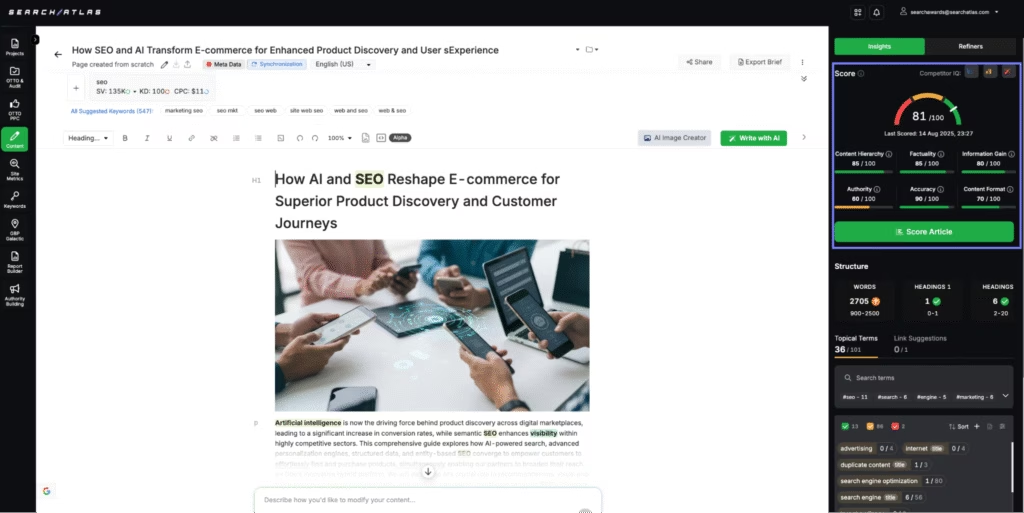
The Search Atlas Content Planner and Topical Map Generator organize keyword clusters into seasonal or trend-based content series, which ensures full topical coverage.
For ongoing performance tracking, the Search Atlas Scholar tool evaluates content quality against semantic SEO benchmarks, identifying improvements that increase rankings and conversions.
This integrated workflow allows B2C brands to go from keyword research to high-converting content in days, not weeks, while ensuring every piece serves both search visibility and sales goals.
5. Build Consumer-Relevant Backlinks
Backlink acquisition for B2C brands focuses on earning links from high-traffic lifestyle blogs, review sites, influencers, and digital publications that consumers trust. B2C backlinks boost domain authority, expand brand reach, and improve rankings for competitive transactional keywords.
The best practices for building B2C backlinks are below.
- Pitch original content or data to consumer media outlets.
- Collaborate with influencers for product reviews or gift guides.
- Create linkable assets like trend reports or seasonal lookbooks.
For example, a home décor retailer could release a “Top 10 Holiday Decor Trends” guide, then pitch it to interior design blogs and lifestyle magazines for coverage and backlinks.
The Search Atlas Backlink Research Tool identifies top referring domains in your niche. Using the Search Atlas Backlink Research Tool makes it easy to see where competitors have earned high-value links, and the Search Atlas outreach features streamline contacting and tracking potential partners. The Search Atlas link-building stack keeps backlink building targeted, relevant, and measurable without relying on mass, low-quality link schemes.
6. Leverage Local and “Near Me” Optimization
For B2C businesses with physical locations or regional service areas, local SEO is a direct path to high-intent traffic and fast conversions. “Near me” searches signal that a consumer is ready to buy, whether they’re looking for a café, clothing store, or same-day delivery option. Capturing these queries requires optimizing not only for your brand but also for geographic relevance.
Strong local visibility comes from complete and consistent Google Business Profile listings, location-focused landing pages, and content that references neighborhoods, landmarks, or events your audience recognizes. Adding authentic local reviews, images, and service details builds trust while reinforcing search relevance.
For example, a boutique targeting “women’s shoes near me” could create a city-specific page featuring bestsellers, customer testimonials, and directions from popular transit stops.
With Search Atlas Local Heatmaps, brands see exactly where they rank across their service area and identify pockets of low visibility, turning local SEO optimization into a measurable growth channel.

How to Conduct a B2C SEO Audit?
A B2C SEO audit evaluates how well your website attracts, engages, and converts consumer traffic from search engines.
The 10 steps for a comprehensive B2C SEO audit are below.
- Analyze keyword rankings and visibility. Review performance for both branded and non-branded B2C terms. Document positions, search volume, and CTR for high-intent queries.
- Assess technical infrastructure. Check site speed, mobile responsiveness, SSL, and Core Web Vitals.
- Evaluate content relevance. Ensure product, category, and blog pages target consumer search intent with accurate, persuasive copy.
- Review on-page optimization. Audit titles, meta descriptions, headers, images, and schema markup. As part of its auditing process, OTTO SEO identifies all of those factors for you and optimizes any issues found in a single click.
- Check competitor benchmarks. Compare keyword coverage, backlink quality, and SERP features with top B2C competitors.
- Analyze backlink profile quality. Identify high-authority consumer-facing sites linking to you and address toxic links.
- Audit local SEO performance. Review Google Business Profile accuracy, citations, and local ranking coverage.
- Evaluate conversion paths. Test CTAs (call-to-action), product page UX (user experience), and checkout flow.
- Check analytics and tracking. Ensure Google Analytics 4 and Google Search Console are capturing accurate data for user behavior and conversions, or rely on Search Atlas to do that for you.
- Document recommendations. Prioritize fixes by impact and difficulty, with timelines for implementation.
What are the Best SEO Tools for B2C Marketing?
The best SEO tools for B2C marketing help brands capture high-volume consumer searches, optimize shoppable content, and track performance across highly competitive categories. B2C marketing tools support keyword discovery, on-page optimization, backlink acquisition, and local visibility, core areas that drive organic traffic and sales for consumer-facing companies.
Free tools from Google form a strong base. Google Search Console (GSC) tracks impressions, CTR, and indexation for branded and non-branded queries, while Google Analytics 4 (GA4) highlights the pages and products that generate the most organic revenue. Google Keyword Planner offers initial keyword ideas with volume and CPC data for spotting purchase-ready opportunities.
For advanced execution, the Search Atlas SEO platform is the best platform for B2C SEO because it centralizes the entire workflow. The Keyword Research Tool uncovers transactional and seasonal keyword opportunities, while Content Genius produces SERP-aligned copy for product, category, and blog pages. The Site Auditor resolves technical barriers that slow consumer pages, while Local Heatmaps pinpoint geographic ranking gaps. The Link Building Outreach feature finds and pitches to consumer publications, review sites, and lifestyle blogs relevant to B2C industries and product categories. Combined with the Scholar tool for semantic quality scoring and the Report Builder for branded client reporting,
The Search Atlas SEO tools deliver an end-to-end system that makes complex B2C SEO campaigns manageable in one place.
How to Start a B2C SEO Agency?
Starting a B2C SEO agency requires expertise in high-volume consumer search behavior, competitive content strategies, and conversion-focused optimization. Unlike B2B, where lead nurturing dominates, B2C SEO services focus on driving immediate traffic and measurable sales through organic visibility.
The 6 steps to launch a successful B2C SEO agency are below.
- Build B2C SEO expertise. Master keyword research for consumer markets, local SEO, and content formats that convert in short buying cycles.
- Choose a target niche. Specialize in industries like fashion, beauty, food, or home goods to deepen expertise and win trust.
- Develop service packages. Offer tiered plans that include keyword targeting, on-page optimization, backlink acquisition, and local SEO.
- Assemble a skilled team. Hire content creators, technical SEOs, and outreach specialists who understand consumer trends.
- Leverage white-label solutions. Use White Label SEO to deliver branded reporting and client dashboards without building tools from scratch.
- Showcase client results. Publish case studies that highlight traffic growth, ranking gains, and ROI to position your agency as a professional search engine optimization company.
For agencies managing large consumer brands, pairing Enterprise SEO strategies with tools like Search Atlas ensures scalable keyword targeting, technical auditing, and content creation across multiple product lines.
What is the relation between B2C (Business-to-Consumer) SEO and SaaS SEO?
B2C SEO and SaaS SEO intersect when software companies sell directly to individual consumers rather than to businesses. In these cases, SaaS SEO applies B2C principles (such as targeting high-volume transactional keywords, optimizing for short decision cycles, and focusing on visual and mobile search) to promote subscription-based digital products.
While traditional SaaS SEO often follows a B2B model with educational, lead-focused content, B2C-oriented SaaS brands emphasize quick conversions, trial sign-ups, and user experience. Both B2C SEO and SaaS SEO rely on keyword research, content optimization, and authority building, but the weighting of tactics shifts based on audience behavior and purchase timelines.
What is the Difference between B2C (Business-to-Consumer) SEO and B2B (Business-to-Business) SEO?
B2C SEO appeals to individual consumers using emotional triggers, lifestyle aspirations, and immediate gratification, while B2B SEO targets business decision-makers with rational, ROI-focused messaging. B2C SEO addresses short purchasing cycles and single-decision buyers, compared to B2B’s longer evaluation periods and multiple stakeholders. The approaches differ in keyword strategy, content formats, and conversion goals.
B2C SEO targets broad consumer search terms and trending topics, creates visually engaging and persuasive content that drives quick action, focuses on direct sales and brand awareness, emphasizes mobile experience and visual appeal, and uses concise, product-focused copy optimized for fast consumption.
B2B SEO targets industry-specific terminology and technical specifications, produces educational content that demonstrates expertise and thought leadership, focuses on lead generation and nurturing through extended sales funnels, emphasizes credibility and compliance, and relies on long-form content that addresses complex business challenges.
B2C SEO examples include optimizing retail product pages for terms like “best running shoes” or “affordable home decor,” while B2B SEO examples include ranking for “enterprise project management software” or “industrial equipment maintenance services.”
What to know about B2C SEO besides Local SEO?
B2C SEO and local SEO both aim to capture consumer search traffic, but they operate at different scopes. Local SEO targets geographic-specific searches like “coffee shop near me” or “plumber in Chicago,” focusing on visibility in Google Maps, local packs, and regional organic results. It emphasizes Google Business Profile optimization, local citations, and proximity-based ranking factors.
B2C SEO, on the other hand, targets consumers at a broader scale, including national or global audiences, and covers a wider range of intent types, from informational searches (“how to style a maxi dress”) to transactional product queries (“buy wireless earbuds online”). While local SEO is a subset of B2C SEO for location-based businesses, many consumer brands need non-local strategies that optimize for eCommerce, seasonal trends, and brand-building content, too.




